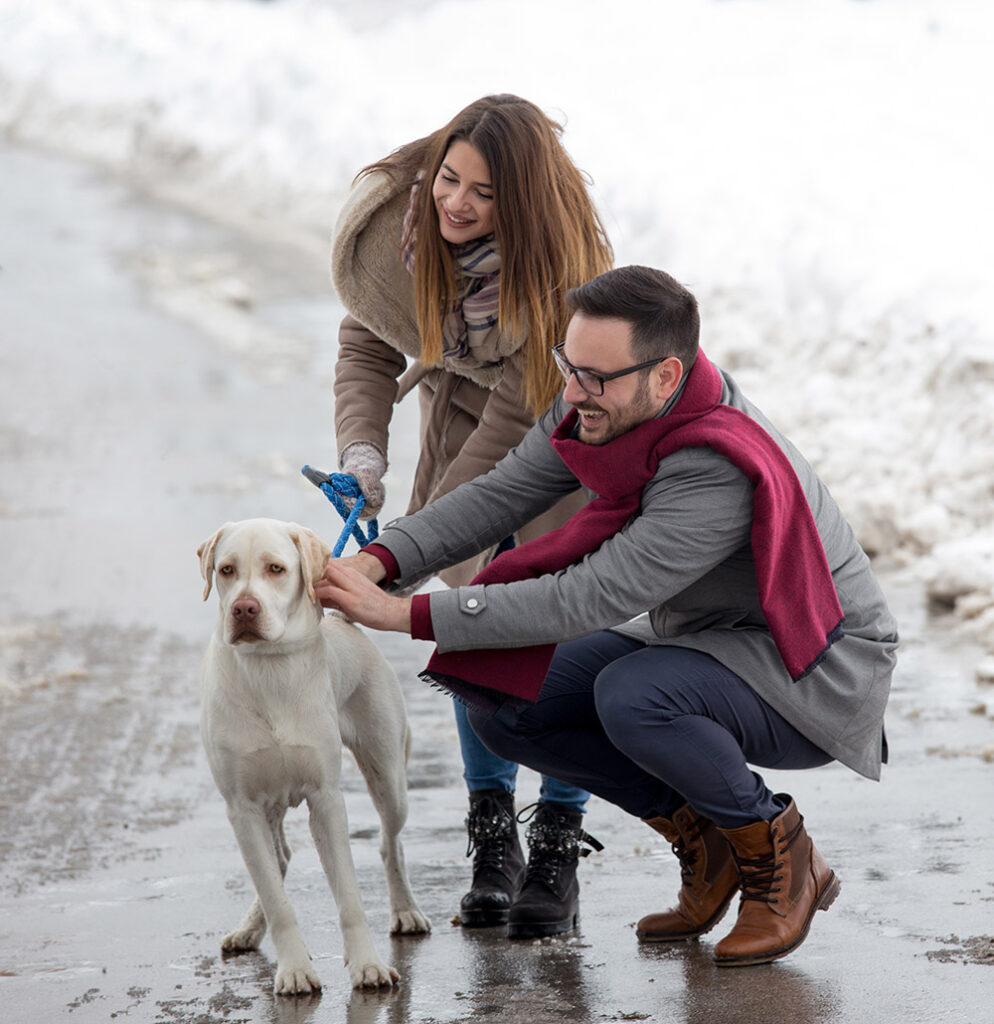Finding the best conditions to walk our four-legged companions while cold weather is setting in might be an uphill battle. We must figure out the sweet spot between providing the necessary activity for a dog’s well-being and preventing them from the risks associated with winter weather.

In this guide, join us and see how cold is too cold for dog paws while exploring factors such as body temperatures and breed-specific considerations related to it.
In this article:
How Cold Is Too Cold To Walk A Dog?
A dog’s tolerance to cold can vary depending on age, breed, size, and health conditions. Small breeds with short-trimmed hair can feel unpleasant when the temperature dips under 45°F (7°C), while larger breeds might suffer when it’s 20°F (-7°C).
Some vets shared that if you are freezing when standing outside, your dog might suffer the same way.
Let’s have a look at how cold a dog can basically tolerate.
| Temp (°F) | Small Dogs | Medium or Large Dogs | Endangered Possibility |
| 45 or above | At ease | At ease | Low |
| 32 – 45 | Unpleasant | At ease | Average for small breeds |
| 20 – 32 | High risk | Unpleasant | High for small breeds, average for large ones |
| Below 20 | Extreme risk | High risk | Extremely high for all canines |
Note: Little dogs weigh less than 15 pounds, whereas medium or large ones weigh more than 15 pounds.
Factors That Influence A Dog’s Tolerance To Cold
Coat Type

Different dog breeds have varying levels of tolerance to cold. Canines with thick or luxurious double fur, like Siberian Huskies or Malamutes, can withstand cold spells better.
These breeds have evolved in Northern climates and may also have other structural, functional, or behavioral characteristics, enabling them to adapt to frigid weather.
On the other hand, short-haired breeds, such as Greyhounds or Xoloitzcuintli, may need more care in colder temperatures.
Coat Color
On bright days, other dark-coated dogs, like black or brown, can soak up a lot of heat from the sun, conserving it to warm their bodies, whereas lighter-coated canines cannot.
Size & Weight
Smaller dogs, due to their larger skin-to-body ratio, lose heat more quickly than larger dogs. This makes them more susceptible to the cold, requiring additional care during winter walks.
Body fat is an effective insulator, with thinner dogs becoming cold faster than bigger ones.
Age & Health
Young puppies, elderly dogs, and those with health difficulties have a more difficult time regulating their body temperatures than healthy canines. As a result, they require more protection against the cold.
Puppies and older dogs, as well as those with medical issues such as arthritis, are especially susceptible to severe temperatures. Dogs habituated to colder temperatures typically have more tolerance; however, those accustomed to indoor existence may find it more difficult in colder settings.
Activity Level
Active furry friends create more body heat, which improves their capacity to withstand cold temperatures. Consistent movement keeps them warm, and their increased energy levels render them more cold-resistant.
Every dog is unique, with different comfort levels and energy requirements. Look for indicators of cold-related discomfort, such as prolonged shallow breathing or a hunched stance. Adjust your walks to meet their specific needs, striking a balance between daily exercise and pleasant indoor moments.
Weather Patterns
Wind chill, humidity, and precipitation all contribute significantly to how cold it feels. Wind, in particular, can make the outdoor temperature feel colder than it is, reducing a dog’s comfort outside.
What To Do When Too Cold To Walk A Dog? Protect Them In Winter
Keep Your Pals Warm

When walking our clients’ dogs on cold days, we usually bundle up those babies with sweaters, jackets, or winter boots to embrace them with extra warmth. Choose gears that fit well to guarantee comfort for our doggies!
Take Easy Walks
You can choose the warmest part of the day for your winter walks because sometimes short, frequent walks can beat the cold better than lengthy ones. Also, according to veterinarians, temperatures below 20°F can boost the risk of cold injury, like frostbite. So, don’t take your little furball outside then.
Check Their Paws Regularly
Dog’s paws can be sensitive to cold, salt, and ice-melting chemicals. And we aren’t sure about the sidewalks. Snow, ice, and salt can find their way into your dog’s paws every time.
Therefore, it’s crucial to shield their vulnerable paws from cold weather. We always tell our communities at PetsitUSA to use dog-friendly and waterproof booties or apply a moisturizing balm to keep dryness and cracks at bay.
After walks, check your dog’s paws for any signs of injury or discomfort.
Keep The Fur Dry
If your furry friend gets wet, dry them immediately to minimize heat loss or the risk of them catching a chill. Give them a good rubdown from their head and move along the back, legs, and tail.
Which Dog Breeds Can Withstand Extreme Cold?
Alaskan Malamute: Originating from Alaska, Malamutes were bred for high endurance and strength in harsh Arctic conditions. Alaskan Malamutes’s dense fur keeps them warm even in frigid temperatures.
Siberian Husky: From Siberia, Siberian Huskies have an equivalent adaptability to cold climates. Their thick coat acts as a shield against freezing temperatures, letting them stand strong under the cold.
Bernese Mountain Dog: Besides dense fur, their strong and sturdy build also contributes to their endurance in chilly conditions.
Saint Bernard: The species has a thick, water-resistant coat that aids in insulation. Their large size and substantial bone structure are also credited to their ability to navigate and endure the cold.
Newfoundland: Newfoundlands have a water-resistant double shield. This breed’s webbed feet and powerful swimming abilities are key adaptations that allow them to handle icy terrain comfortably.
Tibetan Mastiff: Originating in the Himalayan region, these canines can adapt to high altitudes and extreme temperatures due to their sturdy build.
FAQs
Can I walk my dog when it’s snowing or raining outside?
Dogs enjoy these weather conditions, so it’s generally fine. However, keep in mind your dog’s breed and size. If they are short-haired or smaller breeds, they might get cold faster. Prepare in advance for your little fella with a suitable coat or sweater. Also, wipe their paws and bellies regularly to remove snow, mud, or ice balls.
Should we let our dog walk on ice or snow?
It won’t be a problem. But again, keep an eye on their paws if they show any sign of discomfort or irritation. Be cautious of the ice ’cause it can be slippery. If your dog has sensitive paws or the weather is extremely cold, try using protective gear like dog boots.
How do I introduce my dog to wearing a coat?
First, choose a comfortable coat that fits the pups well. Let them sniff and investigate the winter coat before putting it on. Try with short sessions and gradually increase the time your dog wears the coat.
You could use treats and praise to create positive associations. Over time, they will likely adjust to wearing the coat, especially when associating it with enjoyable activities like walks.
See more:
Conclusion
Determining how cold is too cold for dogs involves multiple times of observation, consideration, and knowledge about their well-being. By embracing a mindful approach to winter walks, you can provide your lovely companion with a season of joy and outdoor exploration without any adverse effects. So, leash up, bundle up, and enjoy those wintry adventures together!






